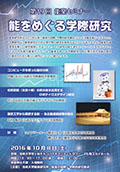Achievement
Nō Theatre Seminar “The Interdisciplinary Research on Nō”
Saturday, October 8 13:30-17:00
Venue: Hōsei University Ichigaya Campus, Boissonade Tower, 26F Sky Hall
ITŌ Katsunobu, Basic Research for Computer-Based Musical Analysis of Utai
NAKAGAWA Shinobu, “Robotics Design Applied an Expert’s Technique of Traditional Performance Art (Japanese Bunraku and Nō )”
TAKAMURA Masahiko, Nō Analyze from History Engineering- The Reconstruction Space of the “Koka-Kanjin-Nō Picture Scroll”
Discussion Commentator: MINORIKAWA Gaku, YOKOYAMA Tarō
The 19th Nō Theatre Seminar under the theme of “The Interdisciplinary Research on Nō” was held, with an invitation to scientists and engineers who have studied Nō from the perspectives of their own disciplines. Director YAMANAKA Reiko of the Noh Theatre Research Institute explained the purpose and scope of the seminar as: firstly, to conduct scientific and objective studies of various elements of Nō (utai or singing, mai or dancing, men or masks, shozoku or robes and butai or stage), and secondly, to consider the possibilities of the wisdom and aesthetic values developed through the long history of Nō interacting with state of-the-art technologies and research, to bring about innovative and unforeseen results. Prof. ITŌ Katsunobu reported on the methods and outcomes of his research (Project title: “Basic Research for Computer-Based Musical Analysis of Utai”). He revealed some characteristics of tsuyogin (strong chanting) and yowagin (weak chanting) and demonstrated some examples. Prof. NAKAGAWA Shinobu reported on his research into robot kinetics to improve the movement of robots by incorporating Bunraku puppet movements (Project title: “Robotics Design Applied an Expert’s Technique of Traditional Performance Art (Japanese Bunraku and Nō)”). He also stated his willingness to study the expressions of nōmen (masks) to be applied to robot expressions. Prof. TAKAMURA Masahiko’s presentation was on the methods of measuring the dimensions of an entire Nō theatre, including the butai or stage, sajiki or seats, backstage and the site where the theatre was constructed, as depicted in Koka Kanjin-Nō Emaki (a picture scroll of Kanjin-Nō performed during the Koka era) and recreate it using computer graphics (Project title: “Nō Analyze from History Engineering-The Reconstruction Space of the ‘Koka- Kanjin-Nō Picture Scroll’”). He also referred to how utai (songs) and hayashi (music) would sound like in the recreated theatre. Prof. TAKAMURA and his students exhibited model of Koka Kanjin-Nō theatre in the hall lobby. Associate Prof. YOKOYAMA Tarō and Prof. MINORIKAWA Gaku served as commentators in the discussion. Prof. MINORIKAWA has contributed remarks on the seminar which is included in the first page of this report. The seminar was attended by about 70 people.
19th Nō Theatre Seminar “The Interdisciplinary Research on Nō” MINORIKAWA Gaku (Professor, HŌSEI University, Faculty of Science and Engineering)
On October 8, 2016, I participated as a commentator at the 19th Nō Seminar hosted by the Noh Theatre Institute of Hosei University. The theme of the seminar is “the interdisciplinary research on Nō”. Engineering approach is the quantification of object or modeling by mathematical expression. Whether the object is car or traditional art, this is the only one methodology. Although it seems somewhat tasteless and artificial, recent digitization is so precise and huge and computers are instantaneously processing data far beyond the resolution of human senses. As a result, no one can perceive its roughness. So we might say it would be possible to implement the Nō music or work into a computer and convert it to a numerical value and reproduce them exactly…but it would not yet. On the other hand, engineering is simplification and extraction work of phenomena, which is a kind of engineer’s delight. In the seminar, three researchers approached the Nō world with unique and cutting edge techniques. For me, the commentator was quite a challenge, not only I could take a glance at the entrance of classic and wonderful Japanese art, but also it was an unexpected harvest to reconfirm the possibilities and future of the engineering itself.





